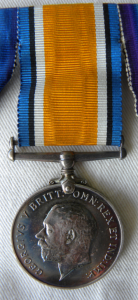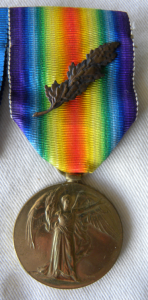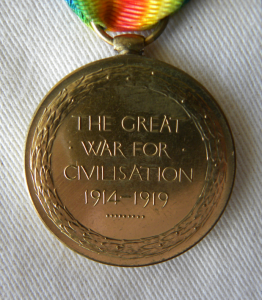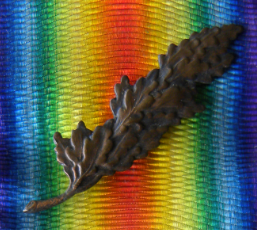EDINBURGH UNIVERSITY ALUMNUS SERVED IN SERBIA IN CHARGE OF A MEDICAL MISSION AND EARNED THE ORDER OF ST. SAVA, ONE OF SERBIA’S HIGHEST HONOURS
 During the First World War, and just shy of 100-years ago in June 1915, Colonel Sir William Hunter, an Edinburgh University alumnus, was appointed as a Grand Officer of the Serbian Order of St. Sava.
During the First World War, and just shy of 100-years ago in June 1915, Colonel Sir William Hunter, an Edinburgh University alumnus, was appointed as a Grand Officer of the Serbian Order of St. Sava.

The Serbian Order of St. Sava – Medallion/badge with ribbon. Coll-1146 – Medals, awards and decorations of William Hunter
Hunter had been serving in Serbia with the British Military Sanitary Mission and there he developed de-lousing techniques to control typhus. In Serbia he was associated with the use of the ‘Serbian barrel’ for disinfection and the eradication of lice.
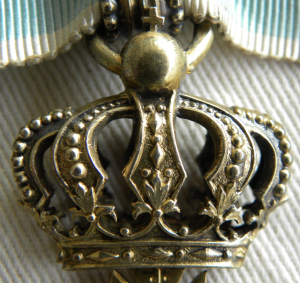
The Serbian Order of St. Sava – Detail. Coll-1146 – Medals, awards and decorations of William Hunter
William Hunter was born on 1 June 1861 in Ballantrae on the Ayrshire coast. He was educated at Ayr Academy, and then studied Medicine at Edinburgh University, graduating in 1883 with M.B., C.M. (1st Class) 1883, and M.D. (Gold Medal) 1886. He served as a house physician at the Royal Infirmary, Edinburgh, and as a Physican to the Western Dispensary, Edinburgh. He had also studied overseas at Leipzig in 1884 with a grant from the British Medical Association, and during the period 1887-1890 he visited Vienna and Strasbourg.
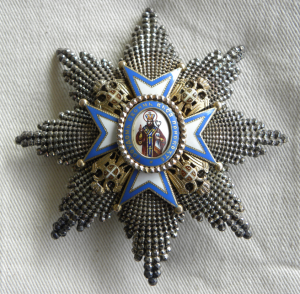
The Serbian Order of St. Sava – Breast Star. Coll-1146 – Medals, awards and decorations of William Hunter
Also during 1887-1890 Hunter worked full time on laboratory research at Cambridge, devoting himself to pernicious anaemia. He was the first person to note that the alimentary and the nervous system were often affected in this disorder. From 1895, Hunter was affiliated with the Charing Cross Hospital and the London Fever Hospital. Earlier, in 1894, he married Beatrice Fielden, daughter of Joshua Fielden MP.
 Along with Julius Otto Ludwig Moeller (1819-1887), a German Professor of Medicine and Surgery from Königsberg (now Kaliningrad), he is associated with ‘Hunter’s glossitis’ caused by B12 or folic acid deficiency (‘Moeller-Hunter glossitis’).
Along with Julius Otto Ludwig Moeller (1819-1887), a German Professor of Medicine and Surgery from Königsberg (now Kaliningrad), he is associated with ‘Hunter’s glossitis’ caused by B12 or folic acid deficiency (‘Moeller-Hunter glossitis’).
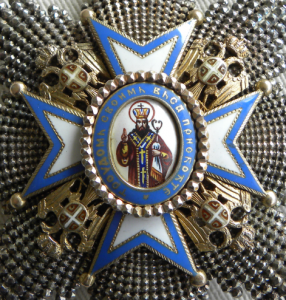
The Serbian Order of St. Sava – Detail, with wording in older cyrillic letters ‘One’s own work achieves all’. Coll-1146 – Medals, awards and decorations of William Hunter
As far as wartime Serbia is concerned however, the country had been ravaged by a disastrous epidemic of typhus lasting from November 1914 to March 1915. Indeed, it was estimated that around 500,000 people were affected by the disease, and of these some 150,000 died, along with 30,000 Austrian prisoners-of-war. Many physicians also lost their lives. An appeal was made by the Serbian government to the British Foreign Office for a mission of doctors, and Hunter who was senior physician at the London Fever Hospital at the time was given the task of building a team. In his role as Colonel in charge of the British Military Sanitary Mission in early-1915, Hunter put into place preventive measures, but the most successful treatment was achieved after steam dis-infestation using improvised tin barrels – the so-called ‘Serbian Barrel’.

In addition to the honour of his appointment as a Grand Officer of the Serbian Order of St. Sava for medical services to Serbia, in January 1916 Hunter was mentioned in Dispatches (Dardanelles) and was awarded the Companion Order of the Bath (CB). He went on to become President of the Advisory Committee, Prevention of Disease, in the Eastern Mediterranean and Mesopotamia (Gallipoli, Egypt, Salonika, Malta and Palestine), and he served with the Eastern Command, 1917-1919, as Consulting Physician. He continued to hold the rank of Colonel.

The Serbian Order of St. Sava – Detail, oval enamelled portrait of the Prince Bishop St. Sava (Rastko Nemanjić). Coll-1146 – Medals, awards and decorations of William Hunter
St. Sava is most important saint of the Serbian Orthodox Church and the patron saint of Serbia. The Order of St. Sava was a decoration instituted by the Serbian King, Milan I (1854-1901), in 1883. The Order was established to recognize civilians for meritorious achievements to the Church, to arts and sciences, the royal house and the state. In 1914 a change was made permitting military personnel to receive the honour for military merit. After the ending of the First World War, the Order of St Sava was awarded by the king of then-Yugoslavia until the abolishment of the monarchy in 1945 (Serbia had been a part of the Kingdom then Republic of Yugoslavia between 1918 and the early 1990s).
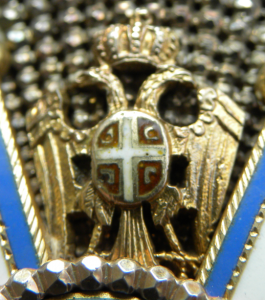
The Serbian Order of St. Sava – Detail, Serbian Eagle and Cross. Coll-1146 – Medals, awards and decorations of William Hunter
Five grades of the Order of St. Sava were awarded: Grand Cross, Grand Officer, Commander, Officer and Knight. Other very varied recipients of the Order were Nikola Tesla (electrical engineer, physicist 1856-1943), Peter Norman Nissen (mining engineer, developer of pre-fab’ shelter 1871-1930) and Helen Keller (author, political activist, lecturer 1880-1968).
 Hunter’s published work includes: Oral sepsis as a cause of ‘Septic gastritis’, ‘Toxic neuritis’ and other septic conditions (1901); Pernicious anaemia: its pathology, septic origin, symptoms, diagnosis, and treatment. Based upon original investigations (1901); A research into epidemic and epizootic plague (1904); Severest anaemias. Their infective nature, diagnosis and treatment (1909); Historical account of Charing Cross hospital and medical school (University of London): original plan and statutes, rise and progress (1914); and, The Serbian epidemics of typhus and relapsing fever in 1915: Their Origin, Course, and Preventive Measures employed for their Arrest (1920).
Hunter’s published work includes: Oral sepsis as a cause of ‘Septic gastritis’, ‘Toxic neuritis’ and other septic conditions (1901); Pernicious anaemia: its pathology, septic origin, symptoms, diagnosis, and treatment. Based upon original investigations (1901); A research into epidemic and epizootic plague (1904); Severest anaemias. Their infective nature, diagnosis and treatment (1909); Historical account of Charing Cross hospital and medical school (University of London): original plan and statutes, rise and progress (1914); and, The Serbian epidemics of typhus and relapsing fever in 1915: Their Origin, Course, and Preventive Measures employed for their Arrest (1920).
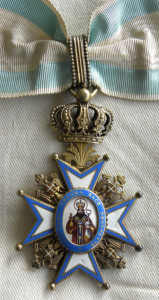
The Serbian Order of St. Sava – Medallion/badge with ribbon. Coll-1146 – Medals, awards and decorations of William Hunter
William Hunter was a Fellow of the Royal College of Physicians (FRCP London 1896) and a Fellow of the Royal Society of Edinburgh (FRSE).
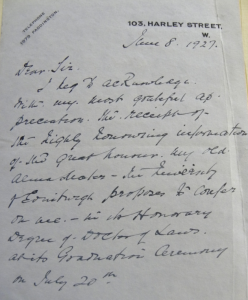
Letter from William Hunter acknowledging the award of Hon. LLD. to be conferred on him by Edinburgh University. EUA INI/ADS/STA/15 1914-1930. Acceptances of Honorary Degrees
In 1927 he was awarded an Honorary LL.D. by Edinburgh University, and acknowledging the notification of award in a letter dated 8 June 1927, Hunter offers his ‘most grateful appreciation […] of the great honour’ his alma mater has conferred on him.
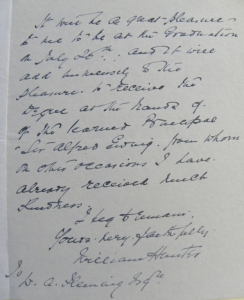
Letter from William Hunter acknowledging the award of Hon. LLD. to be conferred on him by Edinburgh University. EUA INI/ADS/STA/15 1914-1930. Acceptances of Honorary Degrees
The letter goes on: ‘It will be a great pleasure to me to be at the Graduation on July 20th’.
Colonel Sir William Hunter died on 13 January 1937.
 Dr. Graeme D. Eddie, Assistant Librarian Archives & Manuscripts, Centre for Research Collections
Dr. Graeme D. Eddie, Assistant Librarian Archives & Manuscripts, Centre for Research Collections
Sources used included online medal sites, and: (1) University of Edinburgh. Roll of Honour 1914-1919. p.383, Edinburgh: Oliver & Boyd, 1921 (2) Serbia under typhus in 1915. p.219. The British Journal of Nursing. 10 April 1920 (3) Bosiljka M. Lalević-Vasić. History of dermatology and venereology in Serbia – part III/2 ; Dermatovenereology in Serbia from 1881-1918. p.162. Serbian Journal of Dermatology and Venereology 2009 (4), pp.159-165
![]() The British War Medal was awarded to those who served in the campaigns of the Great War or World War between 5 August 1914 (the day following the British declaration of war against the German Empire) and the armistice of 11 November 1918… both dates inclusive. As war approached again in the mid-1930s, this Great War or World War became known as World War One.
The British War Medal was awarded to those who served in the campaigns of the Great War or World War between 5 August 1914 (the day following the British declaration of war against the German Empire) and the armistice of 11 November 1918… both dates inclusive. As war approached again in the mid-1930s, this Great War or World War became known as World War One.![]() The British War Medal – a medal of the First World War – was established on 26 July 1919. In its Silver version, 6,390,000 were awarded. Some 110,000 Bronze versions of the medal were awarded to labour battalions. The British War Medal was designed by the Aberdeen-born sculptor William McMillan (1887-1977).
The British War Medal – a medal of the First World War – was established on 26 July 1919. In its Silver version, 6,390,000 were awarded. Some 110,000 Bronze versions of the medal were awarded to labour battalions. The British War Medal was designed by the Aberdeen-born sculptor William McMillan (1887-1977).![]() The British War Medal shown here was the one awarded to Edinburgh University alumnus William Hunter who served in Serbia during the Great War (see the May 2015 post of these Untold Stories, ‘William Hunter & the Order of St. Sava’). Hunter was President of the Advisory Committee, Prevention of Disease, in the Eastern Mediterranean and Mesopotamia (Gallipoli, Egypt, Salonika, Malta and Palestine), and he also served with the Eastern Command, 1917-1919.
The British War Medal shown here was the one awarded to Edinburgh University alumnus William Hunter who served in Serbia during the Great War (see the May 2015 post of these Untold Stories, ‘William Hunter & the Order of St. Sava’). Hunter was President of the Advisory Committee, Prevention of Disease, in the Eastern Mediterranean and Mesopotamia (Gallipoli, Egypt, Salonika, Malta and Palestine), and he also served with the Eastern Command, 1917-1919.![]() Dr. Graeme D. Eddie, Assistant Librarian Archives & Manuscripts, CRC
Dr. Graeme D. Eddie, Assistant Librarian Archives & Manuscripts, CRC
